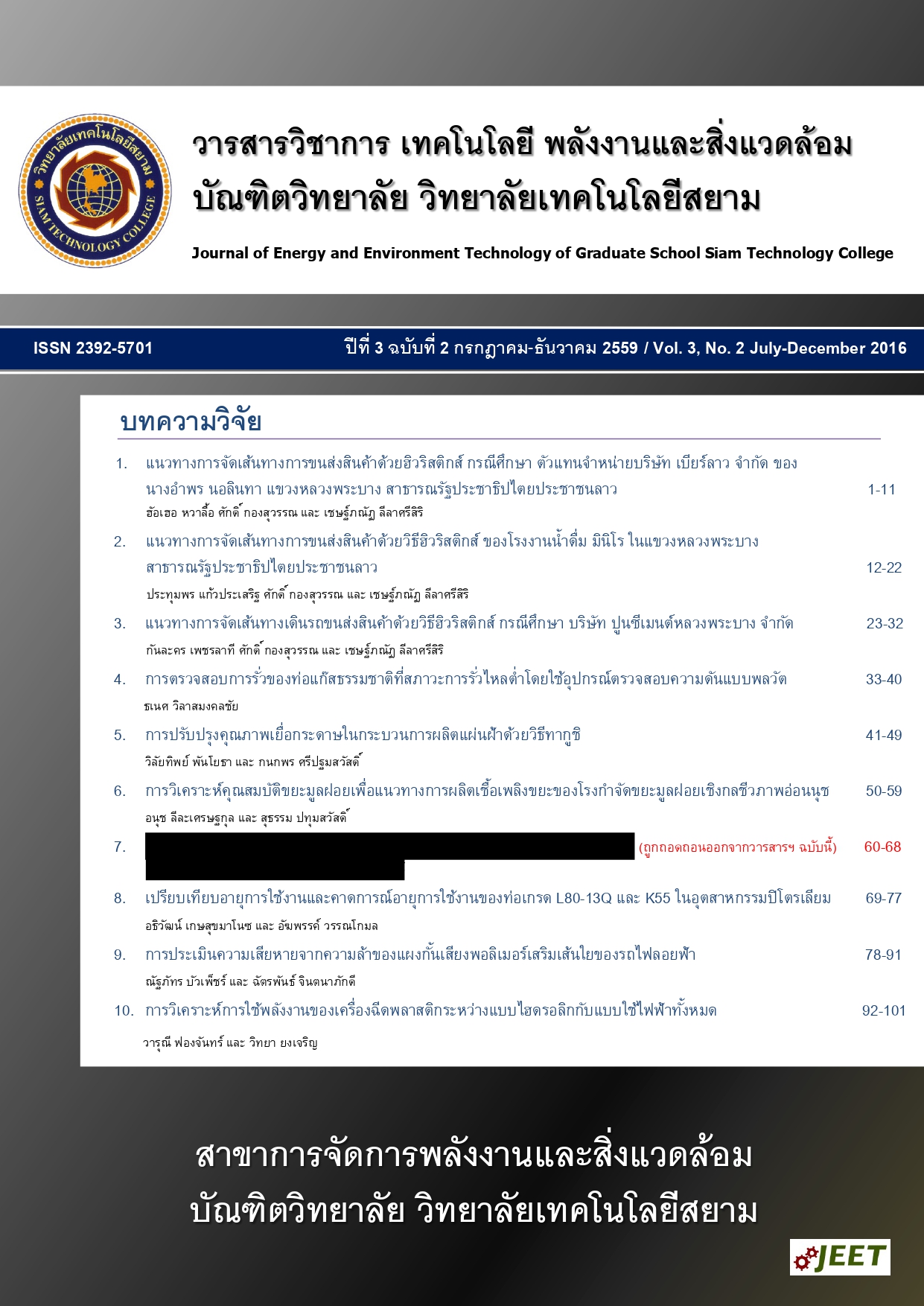Municipal Solid Waste Properties Analysis for Refuse-Derived fuel production in On-Nuch Mechanical Biological Treatment plant
Main Article Content
Abstract
A study was carried out to examine the characteristics of municipal solid waste during composting process in On-Nuch mechanical biological treatment plant. Experiments were performed for determining the moisture content, heating value, proximate and ultimate compositions of waste and compare with European refuse-derived fuel standard. The result showed that municipal solid waste at 40 days of composting process has 20% of moisture content, 13 Mj/kg of heating value and 20% of ash content, hardly pass the European standard. Potential suggestion was discussed for further refuse-derived fuel production.
Article Details
เนื้อหาและข่อมูลในบทความที่ลงตีพิมพ์ในวารสารวิชาการ เทคโนโลยี พลังงาน และสิ่งแวดล้อม บัณฑิตวิทยาลัย วิทยาลัยเทคโนโลยีสยาม ถือเป็นข้อคิดเห็นและความรับผิดชอบของผู้เขียนบทความโดยตรง ซึ่งกองบรรณาธิการวารสารไม่จำเป็นต้องเห็นด้วย หรือว่าร่วมรับผิดชอบใด ๆ
บทความ ข้อมูล เนื้อหา รูปภาพ ฯลฯ ที่ได้รับการตีพิมพ์ในวารสารวิชาการ เทคโนโลยี พลังงาน และสิ่งแวดล้อม บัณฑิตวิทยาลัย วิทยาลัยเทคโนโลยีสยาม ถือเป็นลิขสิทธิ์ของวารสารวิชาการ เทคโนโลยี พลังงาน และสิ่งแวดล้อม บัณฑิตวิทยาลัย วิทยาลัยเทคโนโลยีสยาม หากบุคคล หรือหน่วยงานใดต้องการนำทั้งหมด หรือส่วนหนึ่งส่วนใดไปเผยแพร่ต่อ หรือเพื่อกระทำการใด ๆ จะต้องได้รับอนุญาต เป็นลายลักษณ์อักษรจากวารสารวิชาการ เทคโนโลยี พลังงาน และสิ่งแวดล้อม บัณฑิตวิทยาลัย วิทยาลัยเทคโนโลยีสยาม เท่านั้น
References
[2] Suttibak S and Nitivattananon V. (2005). Enhancing solid waste management capacity of local government authorities: review of current status in Thailand, Proceedings of international conference on integrated solid waste management in Southeast Asian Cities, ISBN 974-8257-34-7, 2005, pp.105-20.
[3] Chaya พ, Gheewala SH. (2007). Life cycle assessment of MSW-to-energy schemes in Thailand, Journal of Cleaner Production, vol. 15(15), 2007, pp. 1463-8.
[4] Saikia N, Kato ร and Kojima T. (2007). Production of cement clinkers from municipal solid waste incineration (MSWI) fly ash, Waste Management, vol. 27, 2007, pp. 1178-89.
[5] KaraM, Gunay E, Tabak Y and Yildiz ร. (2009). Perspectives for pilot scale study of RDF in Istanbul, Waste Management, vol. 29, 2009, pp. 2976-82.
[6] Jidapa Nithikul, Obuli. p. Karthikeyan and c. Visvanathan. (2011). Reject management from a Mechanical Biological Treatment plant in Bangkok, Thailand, Resources, Conservation and Recycling, vol. 55, 2011, pp. 417-422.
[7] Honghong Shi, Nader Mahinpey, Aqsha Aqsha and Rico Silbermann. (2016). Characterization, thermochemical conversion studies, and heating value modeling of municipal solid waste, Waste Management, vol. 48, 2016, pp. 34-47.
[8] ASTM.(2008). standard Test Methods for Moisture in Cellulose, ASTM D1348-94. ASTM International.
[9] ASTM.(2007). standard Test Method for Gross Calorific and Ash Value of Waste Materials, ASTM D5468-02. ASTM International.
[10] ASTM. Standard Test Methods for Proximate Analysis of Coal and Coke by Macro Thermo gravimetric Analysis, ASTM D7582-12. ASTM International.
[11] กิตติกร สาสุจิตต์ (2015). เทคโนโลยีเชื้อเพลิง'ชีวภาพและชีวมวล กระบวนการแปลงสภาพและคุณสมบัติ เชื้อเพลิงชีวมวล. เชียงใหม่ : มหาวิทยาลัยแม่โจ้.
[12] Gendebien et al. (2003). Refuse Derived Fuel, Current Practice and Perspectives (B4- 3040/2000/306517/MAR/E3), European Commission - Directorate General Environment


